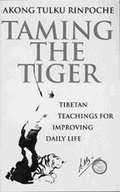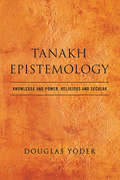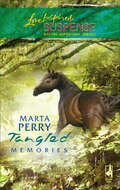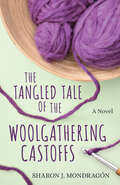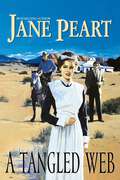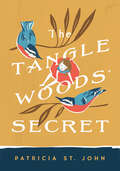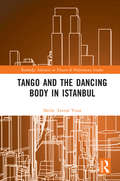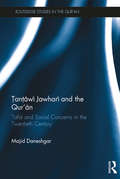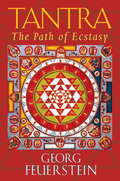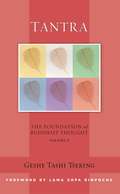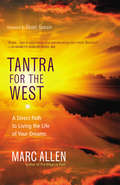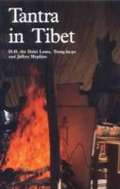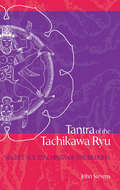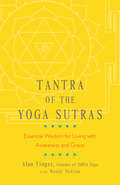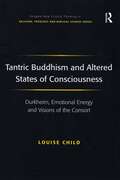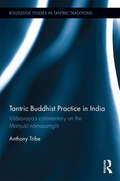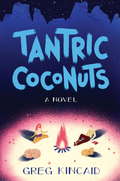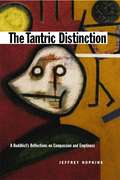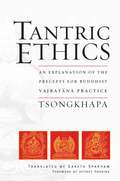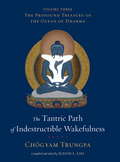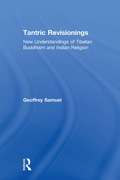- Table View
- List View
Taming The Tiger: Tibetan Teachings For Improving Daily Life
by Akong Tulku RinpocheTAMING THE TIGER offers a simple approach to finding happiness for oneself that also brings happiness to others. Based on twenty years of Buddhist teaching in the West, Taming the Tiger aims to help anyone seeking the truth about suffering and happiness. The first part of the book deals with topics such as Impermanence, The Right Motivation, Facing the Situation, Body, Speech and Mind, Compassion, and Mindfulness. The second part is devoted to exercises, meditations and relaxation techniques for body and mind, including Feeling, Openness, Taking Suffering, Bringing the Buddha to Life and Universal Compassion. The exercises, designed to provide a base of self-knowledge, mind-therapy and self-healing have also been found beneficial in therapy workshops and in the treatment of psychological problems.This practical programme has been tested and refined first at therapy workshops of Samye Ling in Scotland - the oldest Tibetan Buddhist centre in the West - and has since confirmed its success in cities throughout Europe, North America and Africa, bringing definitive solutions to long-term problems weighing heavily on the mind.
Tamizhar Nagarigamum Panpadum
by A. DhatchinamoorthyThe book talks about ancient Tamil Nadu and its deeply enriched culture,customs,festivals,social set up,beliefs,art and architecture and forms a great reference text on this subject.
Tanakh Epistemology: Knowledge and Power, Religious and Secular
by Douglas YoderIn this volume, Douglas Yoder uses the tools of modern and postmodern philosophy and biblical criticism to elucidate the epistemology of the Tanakh, the collection of writings that comprise the Hebrew Bible. Despite the conceptual sophistication of the Tanakh, its epistemology has been overlooked in both religious and secular hermeneutics. The concept of revelation, the genre of apocalypse, and critiques of ideology and theory are all found within or derive from epistemic texts of the Tanakh. Yoder examines how philosophers such as Spinoza, Hume, and Kant interacted with such matters. He also explores how the motifs of writing, reading, interpretation, image, and animals, topics that figure prominently in the work of Derrida, Foucault, and Nietzsche, appear also in the Tanakh. An understanding of Tanakh epistemology, he concludes, can lead to new appraisals of religious and secular life throughout the modern world.
The Tangible Kingdom
by Matt Smay Hugh HalterWritten for those who are trying to nurture authentic faith communities and for those who have struggled to retain their faith, The Tangible Kingdom offers theological answers and real-life stories that demonstrate how the best ancient church practices can re-emerge in today's culture, through any church of any size. In this remarkable book, Hugh Halter and Matt Smay "two missional leaders and church planters" outline an innovative model for creating thriving grass-roots faith communities.
Tangled Memories
by Marta PerryDigging into her father’s past brings a woman closer to danger in this inspirational romantic suspense novel.Finally meeting the wealthy family she’d never known should have given Corrie Grant the information about her father she’d craved all her life. But the Mannings of Savannah were a secretive and hostile bunch. All except Lucas Santee, her grandfather’s sophisticated right-hand man, who stood between Corrie and her relatives’ unrelenting barbs and slights.The family’s suspicion of her seemed frivolous at first, but when a mysterious series of accidents occurred, Corrie was forced to take it seriously. How far would the Mannings go to keep their secrets buried forever?
The Tangled Tale of the Woolgathering Castoffs: A Novel (Purls and Prayers)
by Sharon J. MondragónA humorous, heartwarming tale of love, loss, and the power of community Fair Meadows Retirement Community might as well be a country club for most of the retirees enjoying the pool, golf course, and book clubs. But for the caregivers whose family members reside upstairs in the special Memory Care Unit, vacation is over. Comforting these caregivers is exactly why the Woolgatherers group has formed. They make prayer shawls to support those affected by the heartbreaking reality of not being recognized by a loved one-people like Sam Talbot, who has been barely existing since his wife moved into Memory Care. He finds that his life has lost all color and meaning without her. That's something the Woolgatherers can't bear to see. Flirtatious Jenny Alderman, cranky crocheter Edna O'Brian, kind Rose Harker, and the rest of the prayer shawl group weave him into the circle. Sam has no idea how he got tangled up with them, and he's no good at knitting. But when one member talks him into taking up his wife's old crochet hooks, he discovers that this one small gesture might just have the power to heal his life--or even save it. Full of Sharon Mondragon's characteristic humor and heart, this book wrestles with the loneliness of being the forgotten spouse of a dementia patient, moving past the fear that the spouses often face into the love and compassion that can make all the difference.
Tangled Web
by Kristi D. HollAlex is unhappy living with her mother's parents in Indiana while her mother and alcoholic father remain in Texas, and her life becomes more complicated when she uses her computer to act on her suspicions about her grandparents' new neighbor.
A Tangled Web (Westward Dreams)
by Jane PeartPerhaps Jane Peart’s finest novel--the story of a young woman in the early 1900s who overcomes adversity by embracing faith Darcy Welburne has seen enough of politics from the long line of judges in her family. So when Grady, her fiancé, tells her he is running for sheriff, she sets off to find the new freedom promised by the American West. She escapes to Juniper Junction, thinking a teaching job is waiting for her. When she discovers the position has already been filled, she resigns herself to becoming a Harvey Girl--a waitress at the chain of restaurants in the newly opened Arizona territory. Ashamed to tell her family that she is "just a waitress," she becomes a "marvel of make-believe," and, ignoring the pinches of her conscience, she embarks on an elaborate deception, sending home letters full of fictitious students, townspeople, and events recreated from the staff and diners of the Harvey House. Her life seems to be going well. She meets Ted, a handsome young architect. But then Grady shows up with a big group of politicians--including Teddy Roosevelt--and recognizes her. Darcy’s untruthfulness is revealed. She fights with Grady. She loses face before Ted. She has to return to her family and make things right. But through it all, her faith grows stronger and readers are assured that all will work out in the end.
The Tanglewoods' Secret (Patricia St John Series)
by Patricia St. JohnRuth and her beloved brother Philip find solace in the expanse of the Tanglewoods' property. There they escape into bird watching, climbing, and general misadventures with their friend Terry. But life with their Aunt is harsh, and Ruth suffers from an incorrigible temper. Just when she thinks she can't take it anymore, she learns a very special secret about a very special Shepherd. When a dreadful accident hurts one they love, Ruth and Philip learn that the Tanglewoods' Secret isn't meant to be kept a secret.
The Tanglewoods' Secret (Patricia St John Series)
by Patricia St. JohnRuth and her beloved brother Philip find solace in the expanse of the Tanglewoods' property. There they escape into bird watching, climbing, and general misadventures with their friend Terry. But life with their Aunt is harsh, and Ruth suffers from an incorrigible temper. Just when she thinks she can't take it anymore, she learns a very special secret about a very special Shepherd. When a dreadful accident hurts one they love, Ruth and Philip learn that the Tanglewoods' Secret isn't meant to be kept a secret.
Tango and the Dancing Body in Istanbul (Routledge Advances in Theatre & Performance Studies)
by Melin Levent YunaTango and the Dancing Body in Istanbul explores the expansion of social Argentine tango dancing among Muslim actors in Turkey, pioneered in Istanbul despite the conservative rule of the Justice and Development Party (JDP) and Tayyip Erdoğan. In this book, Melin Levent Yuna questions why a dance that appears to publicly represent an erotic relationship finds space to expand and increase dramatically in the number of contemporary Turkish Muslim tango dancers, particularly during a conservative rule. Even during the 2020 Covid-19 pandemic, tango dance classes, gatherings, and messages flourished on YouTube, Facebook, Instagram, and Zoom. Urban Turkey and its tango dance performances provide one symbol and example of how neoliberal capitalism could go hand in hand with conservatism by becoming a bridge between Europe and the Middle East. This study largely focuses on the dancers’ perspective while presenting the policies of Erdoğan. It presents the social characteristics of the tango dancers, the meanings they attach to their bodies and their dance as well as what this dance reflects about them – besides the policies of the Justice and Development Party. The book approaches the tango dance and its dancing body in terms of layers of meaning systems in a neoliberal and conservative context. This study will be of great interest to students and scholars in dance, anthropology, cultural studies, and performance studies.
Tantawi Jawhari and the Qur'an: Tafsir and Social Concerns in the Twentieth Century (Routledge Studies in the Qur'an)
by Majid DaneshgarShaykh Ṭanṭāwī Jawharī was an Egyptian exegete known for having produced a scientific interpretation of the Qurʾān. A pioneering scholar in terms of familiarising the people of his time with many previously neglected matters regarding Islam and science, his publications shocked the Cairo educational system and other Muslim places of learning in the early twentieth century. This book examines the intersection between Ṭanṭāwī Jawharī and Egyptian history and culture, and demonstrates that his approach to science in the Qurʾān was intimately connected to his social concerns. Divided into three parts, part one contains three chapters which each introduce different aspects of Ṭanṭāwī Jawharī himself. The second part explores the main aspects of his tafsīr, discussing his approach to science and the Qurʾān, and how he presented Europeans in his tafsīr, and then addressing the impact of his tafsīr on wider Muslim and non-Muslim society. The third section draws attention to the themes from all 114 sūras of the Qurʾān that are discussed within his commentary. It then analyses the current status of his views and the post-Jawharism perspective on science and the Qurʾān, both today and in an imaginary future, in 2154. Providing new English translations of Ṭanṭāwī Jawharī’s work, the book delivers a comprehensive assessment of this unique figure, and emphasises the distinctive nature of his reading of the Qurʾān. The book will be a valuable resource for anyone studying modern Egypt, the Qurʾān, Islam and Science, and scientific interpretation and inimitability.
Tantra: Path of Ecstasy
by Georg FeuersteinTantra--often associated with Kundalini Yoga--is a fundamental dimension of Hinduism, emphasizing the cultivation of "divine power" (shakti) as a path to infinite bliss. Tantra has been widely misunderstood in the West, however, where its practices are often confused with eroticism and licentious morality. Tantra: The Path of Ecstasy dispels many common misconceptions, providing an accessible introduction to the history, philosophy, and practice of this extraordinary spiritual tradition. The Tantric teachings are geared toward the attainment of enlightenment as well as spiritual power and are present not only in Hinduism but also Jainism and Vajrayana Buddhism. In this book, Georg Feuerstein offers readers a clear understanding of authentic Tantra, as well as appropriate guidance for spiritual practice and the attainment of higher consciousness.
Tantra
by Geshe Tashi Tsering Lama Thubten Zopa Rinpoche Gordon McdougallIn this sixth and final volume in the Foundation of Buddhist Thought series, Geshe Tashi Tsering brings his familiar, helpful approach to the esoteric practices of Buddhist tantra. Anticipating the many questions Westerners have upon first encountering tantra's colorful imagery and veiled language, Tantra uses straight talk to explain deities, initiations, mandalas, and the body's subtle physiology of channels and chakras. Tantric Buddhism provides a quick avenue to buddhahood by means of dissolving the body's wind energies into the central channel at the heart, mimicking the transformations of consciousness that occur at the time of death. Guiding readers systematically from tantra's generation stage through to the full enlightenment of the completion stage, Geshe Tashi Tsering even unpacks a simple compassion practice composed by the Dalai Lama, using it to illustrate the building blocks common to all such visualization techniques. Tantra is a fitting conclusion to this accessible and practical series.
Tantra for the West
by Marc AllenA Direct Path to Living the Life of Your Dreams What does tantra have to do with your relationships, work, money, creativity, sex, food and drink, being alone, meditation and yoga, aging and healing, politics, freedom, and enlightenment? Everything! Tantra is usually thought of as sex with some kind of mysticism thrown in. Marc Allen goes back to the original meaning of tantra and shows how it can be applied to every moment of your life, excluding nothing. Tantra for the West is filled with ancient and modern principles and practices that help you use all your experiences as part of your mental, emotional, and spiritual growth. Within your way of life -- whatever it may be -- within your everyday thoughts and feelings, within your fantasies and dreams are the keys to love, freedom, and fulfillment. As soon as you can see this, you'll find yourself on a direct path to realizing the life of your dreams. This highly acclaimed book has inspired readers all over the world for over thirty years, and is now completely revised, with new material added. It gives you simple keys and practical tools that can be wildly, creatively adapted to your individual needs. If you spend even a brief amount of time with this book, you will discover for yourself the transformative power of tantra.
Tantra in Tibet
by Dalai Lama Jeffrey HopkinsIn the Wisdom of Tibet series, volumes are specially chosen by His Holiness as revealing a true oral tradition.
Tantra of the Tachikawa Ryu
by John StevensThe Tachikawa Ryu is a legendary secret Buddhist sect that taught: "The highest spiritual attainments are best achieved through the physical act of sex." The sect was banished in Japan and went underground hundreds of years ago, but many believe that it is still active. Scholar John Stevens provides-based on actual events, hidden texts, and authentic Tantric tradition-the first explication in English of Tachikawa Ryu teachings, in the form of a symbolic narrative about the young Shingon monk Dai-en and the Zen practitioner Lady Hotoke.What emerges is a fascinating portrait of a little-known aspect of esoteric Buddhism and startling insights into the sexual nature of the rituals of conventional worship as well as the training of Tachikawa Ryu priests and priestesses.This groundbreaking work includes black-and-white photographs of rare artwork and statuary that express the Tachikawa ideal.
Tantra of the Yoga Sutras: Essential Wisdom for Living with Awareness and Grace
by Alan Finger Wendy NewtonA readable, accessible version of the ancient classic primer on the practice of yoga--interpreted by a contemporary Tantric yoga master.The Yoga Sutras is Patanjali’s classic text on how to experience oneness (samadhi) within yoga practice. Serious yoga students want to bring the wisdom of the Sutras to their practice but often find the text impenetrable and difficult to relate to. Here, yogi and Tantric master Alan Finger offers an interpretation of the Sutras that is clear and immediately relevant—and he shows contemporary practitioners that samadhi is something that they can experience here and now. Yoga is a process of spiritual evolution, and samadhi is as natural as breathing and available to all, because it is our true nature. Viewed through a Tantric framework, Finger shows us how the Sutras describe the yogic process that both leads us to the experience of samadhi and allows us to weave the wisdom and grace of that experience back into our everyday life.
Tantric Buddhism and Altered States of Consciousness: Durkheim, Emotional Energy and Visions of the Consort (Routledge New Critical Thinking in Religion, Theology and Biblical Studies)
by Louise ChildThis book explores the role of altered states of consciousness in the communication of social and emotional energies, both on a societal level and between individual persons. Drawing from an original reading of Durkheimian social theorists (including Mauss, Hertz, and Hubert) and Jungian psychology, Louise Child applies this analysis to tantric Buddhist ritual and biographical material. She suggests ways in which dreams and visionary experiences (including those related to the 'subtle body') play an important and previously under-explored role in tantric understandings of the consort relationship.
Tantric Buddhist Practice in India: Vilāsavajra’s commentary on the Mañjuśrī-nāmasaṃgīti (Routledge Studies in Tantric Traditions)
by Anthony TribeUsing a commentary on the influential text, the Mañjuśrī-nāmasaṃgīti, ‘The Chanting of the Names of Mañjuśrī’, this book deals with Buddhist tantric meditation practice and its doctrinal context in early-medieval India. The commentary was written by the 8th-9th century Indian tantric scholar Vilāsavajra, and the book contains a translation of the first five chapters. The translation is extensively annotated, and accompanied by introductions as well as a critical edition of the Sanskrit text based on eight Sanskrit manuscripts and two blockprint editions of the commentary’s Tibetan translation. The commentary interprets its root text within an elaborate framework of tantric visualisation and meditation that is based on an expanded form of the Buddhist Yoga Tantra mandala, the Vajradhātu-maṇḍala. At its heart is the figure of Mañjuśrī, no longer the familiar bodhisattva of wisdom, but now the embodiment of the awakened non-dual gnosis that underlies all Buddhas as well their activity in the cosmos. The book contributes to our understanding of the history of Indian tantric Buddhism in a period of significant change and innovation. With its extensively annotated translation and lengthy introductions the book is designed to appeal not only to professional scholars and research students but also to contemporary Buddhists.
Tantric Coconuts
by Greg KincaidFrom the New York Times bestselling author of A Dog Named Christmas! Zen and the Art of Motorcycle Maintenance meets Life of Pi in this quirky spiritual journey across the wild highways and byways of America. Free spirit Angel Two Sparrow--artist and musician extraordinaire--is having trouble making ends meet. On the verge of desperation, she inherits her crazy Aunt Lilly's bookmobile and half-wolf named No Barks, and dreams up yet another life plan. Painting her business card on the side of the van, Angel and her trusty companion set off on a pilgrimage across America hoping to jump-start her new profession: Native American Spiritual Consultant. Traveling in the other direction, Ted Day and his trusty Irish Terrier-mix Argo are on a much needed vacation (and in need of spiritual nourishment). When he leaves Kansas, Ted can't image how far from his sleepy law office that old silver and black Winnebago 32RQ Chieftain will take him.Two lives (four if you count the canines) collide (literally). Once the dust settles, Ted and Angel find themselves enamored. Sensing that something bigger and more profound has been set in motion, the couple embarks on a wild road trip, detouring into some rarely traveled corridors of the human soul. Very soon, it becomes clear that nothing will ever be the same for these travelers, their dogs, and, heck, the world at large, too. "Coming from the author of books such as A Dog Named Christmas and Christmas with Tucker," Kincaid writes, "This new novel might at first blush sound like a departure for me. And yet, Angel and Ted's journey throughout the Southwest reveals the themes at the heart of all my work: the ultimate questions of life and love, of companionship and overcoming the odds."From the Hardcover edition.
The Tantric Distinction
by Anne C Klein Jeffrey Hopkins"The ideas, concepts, and methods of various religions must be tried on for size, must be lifted above museum displays, must be confronted and allowed to resonate with one's own character. It is in this spirit that I present here a personalized account of central Buddhist practices."--from the author's preface. Widely recognized as one of the West's leading scholars of Tibetan Buddhism, Professor Jeffrey Hopkins is renowned for his textual translations and original scholarship. For ten years he served as the principal English translator for His Holiness the Dalai Lama. The Tantric Distinction is his effort to make accessible the complexities of this highly sophisticated philosophy by sharing his personal, individual experience with Buddhist thought and practice. It lays out the entire Buddhist path as a living experience.
Tantric Ethics: An Explanation of the Precepts for Buddhist Vajrayana Practice
by Jeffrey Hopkins Je Tsongkhapa Gareth SparhamTantra, or Vajrayana, Buddhism is a set of esoteric practices that involve mantra recitation and complex visualizations. Tantra constitutes the fabric of a Tibetan Buddhist's daily practice, but no practice of tantra can be successful without adherence to the tantric precepts, the highest of three complementary sets of vows. Tsongkhapa is perhaps the greatest philosopher ever produced by Tibet's Buddhist culture, and this book is a translation of his explanation of the tantric precepts.
The Tantric Path of Indestructible Wakefulness: The Profound Treasury of the Ocean of Dharma, Volume Three (volume #3)
by Judith L. Lief Chogyam TrungpaThe Profound Treasury of the Ocean of Dharma represents meditation master Chögyam Trungpa's greatest contribution to Western Buddhism. This three-volume collection presents in lively, relevant language the comprehensive teachings of the Tibetan Buddhist path of the hinayana, mahayana, and vajrayana. This work will resonate with new students of Buddhism as well as the most senior students. The third volume, The Tantric Path of Indestructible Wakefulness, presents the vajrayana teachings of the tantric path. The vajrayana, or "diamond vehicle," also referred to as tantra, draws upon and extends the teachings of the hinayana and mahayana. As with the hinayana and the mahayana, the formal acceptance into the vajrayana is marked by a vow, in this case the samaya vow. There is an emphasis at this stage on the student-teacher relationship and on the quality of devotion. Generally, students must complete preliminary practices, called ngöndro, to prepare themselves for initiation into the vajrayana path before going further. Having done so, they then receive the appropriate empowerments to begin tantric practices. There are empowerment ceremonies of many kinds, called abhishekas. The vajrayana includes both form practices, such as visualizations and sadhanas (ritual liturgies), and formless practices based on allowing the mind to rest naturally in its inherent clarity and emptiness. Although on the surface, there is much greater complexity in tantric practices, the principles of mindfulness and awareness and the cultivation of compassion and skillful action continue to be of central importance. The tantric path requires complete engagement and fierce dedication. It is said to be a more rapid path, but it is also more dangerous. There is a quality of directness, abruptness, and wholeheartedness. Tantrikas, or vajrayana practitioners, recognize that the most challenging aspects of life, the energies and play of confused emotions and frightening obstacles, can be worked with as gateways to freedom and realization. Other topics covered in detail in this volume include the four reminders, the mandala principle, mahamudra, atiyoga, and more.
Tantric Revisionings: New Understandings of Tibetan Buddhism and Indian Religion
by Geoffrey SamuelTantric Revisionings presents stimulating new perspectives on Hindu and Buddhist religion, particularly their Tantric versions, in India, Tibet or in modern Western societies. Geoffrey Samuel adopts an historically and textually informed anthropological approach, seeking to locate and understand religion in its social and cultural context. The question of the relation between 'popular' (folk, domestic, village, 'shamanic') religion and elite (literary, textual, monastic) religion forms a recurring theme through these studies. Six chapters have not been previously published; the previously published studies included are in publications which are difficult to locate outside major specialist libraries.
